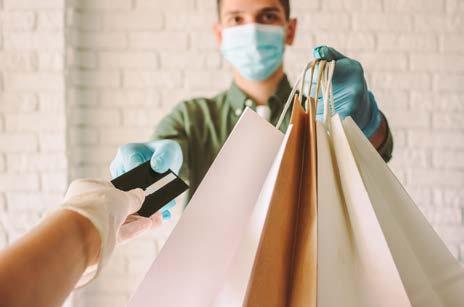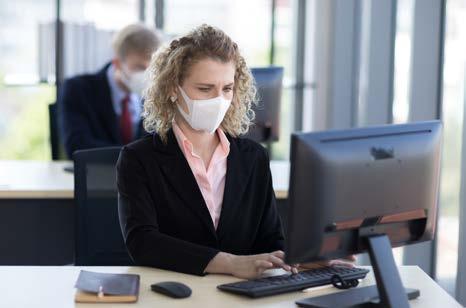
12 minute read
TRAINING & COMMUNICATION
WHO ARE THESE GUIDELINES FOR? These guidelines are suggested for any employees who interact with customers on a face to face basis as part of their job duties. This includes employees greeting customers at counters, windows, outside of a facility, during meetings, etc.
Advertisement

WHAT ARE THE GUIDELINES? These guidelines are methods and procedures designed to decrease the risk of contracting an infectious airborne disease during interactions between employees and customers. Following them will not guarantee immunity from such an infectious disease, but will increase the odds that the employee will not become infected and remain healthy.
GENERAL HYGIENE • Wash hands often with soap and water for at least 20 seconds, especially after going to the bathroom, before eating, and after blowing your nose, coughing, or sneezing. • Use sanitizing solution to clean hands and work surfaces frequently throughout the day. • Using hand sanitizer that contains at least 60% alcohol if soap and water are not available. • Avoiding touching eyes, nose, and mouth with unwashed hands. • Cover coughs and sneezes with a tissue, then throw the tissue in the trash.
• Disinfect and sanitize high-touch areas that customers may use while conducting business. • Stay home if you are experiencing COVID-19 symptoms and report this via telephone to your supervisor and human resources. • Staff has the right to use masks that are not OSHA-regulated without being added to the city’s respiratory protection program. • Employees may use unregulated cloth or surgical masks without any restrictions or controls. • Employees may use gloves while working without regulation or restrictions.
INTERACTING WITH CUSTOMERS • Use social distancing to maintain at least six feet between individuals in all areas of the work environment, including customers. • Set up six foot queue markers to help customers waiting in line maintain safe social distancing. • Unruly customers: » Alert your supervisor or others who can assist. » Ask customer to please leave building. » Contact 911 or local law enforcement. • Use barriers whenever possible to maintain safe separation between you and the customer. • Postpone events where social distancing or other mitigating measures cannot be maintained. • Use telephone contact to conduct business whenever possible. • Use tele-meeting applications to conduct business meetings as the preferred method of contact. • Schedule the minimum amount of people needed for any in-person meetings. • Limit the number of registrants and participants in special events to maintain social distancing. • Customers will have their temperature taken if they wish to enter a facility.
Otherwise if conditions are safe, business may be conducted outside. • Communicate policies in advance to your customers using Employee to
Vendor Guidelines. • Post signage that encourages social distancing and effective hygiene in areas where customers frequent.
WHERE ARE THESE GUIDELINES NECESSARY? These guidelines are necessary in any customer setting. A customer interaction setting could be at a customer counter, on a job site, in a meeting or anywhere else where you are interacting with someone in person.
WHY MUST WE FOLLOW THESE GUIDELINES? Employers are responsible to ensure that employees are provided a work environment that is healthful and safe. Employees are encouraged to follow these guidelines in order to maintain their health while at their place of employment. Following the guidelines will also help to maintain our customer’s health and well-being.
HOW SHOULD I USE THESE GUIDELINES? Risk managers are encouraged to use these guidelines and apply them to employees that work face to face with the entity’s customers in environments such as the entity’s buildings, special events, outdoor settings, and other gatherings involving customers.

WHO ARE THESE GUIDELINES FOR? These guidelines are suggested for any employees who interact with other employees on a face to face basis as part of their job duties. This includes employees working in offices, cubicles, departments, during meetings, or in breakrooms, water fountains, restrooms, or other work spaces.

WHAT ARE THE GUIDELINES? These guidelines are methods and procedures designed to decrease the risk of contracting an infectious airborne disease during interactions between employees. Following them will not guarantee immunity from such an infectious disease, but will increase the odds that the employee will not become infected and remain healthy.
GENERAL HYGIENE • Wash hands often with soap and water for at least 20 seconds, especially after going to the bathroom, before eating, and after blowing your nose, coughing, or sneezing. • Use sanitizing solution to clean hands and work surfaces frequently throughout the day. • Use hand sanitizer that contains at least 60% alcohol if soap and water are not available. • Avoiding touching eyes, nose, and mouth with unwashed hands. • Cover coughs and sneezes with a tissue, then throwing the tissue in the trash. » If not tissue is not available, cough or sneeze into your elbow – not your hands.
• Disinfect and sanitize high-touch areas that customers may use while conducting business. • Create emails, task reminders, or other prompts for staff to sanitize frequently touched areas. » Entry/Exit door handles, timeclocks, light switches, faucets, microwave panels, etc. • Stay home if you are experiencing COVID-19 symptoms and report this via telephone to your supervisor and human resources. • Staff has the right to use masks that are not OSHA-regulated without being added to the city’s respiratory protection program. Check with your supervisor for clarification and local, state, or other guidance given at this time. • Employees may use unregulated cloth or surgical masks without any restrictions or controls. Check with your supervisor for clarification and local, state, or other guidance given at this time. • Employees may use gloves while working without regulation or restrictions.
Check with your supervisor for clarification and local, state, or other guidance given at this time.
INTERACTING WITH EMPLOYEES • Consider having employee schedules staggered so they are not coming in and going out all at the same time. • Use social distancing to maintain at least six feet between individuals in all areas of the work environment. • Set up six foot queue markers to help employees waiting in line to clock in/ out, at office doorways, vending machines, or other frequented spaces to maintain safe social distancing. • Engineer your facilities so employee foot traffic can flow without having to pass through restrictive spaces placing employees within an acceptable six-foot distance. • Use barriers whenever possible to maintain safe separation between you and others. • Postpone proceedings where social distancing or other mitigating measures cannot be maintained. • Use telephone contact to conduct business whenever possible. • Use tele-meeting applications to conduct business meetings as the preferred method of contact. • Schedule the minimum amount of people needed for any in-person meetings. • Limit the number of registrants and participants in special events to maintain social distancing. • Employees may have their temperature taken upon entering a facility.
Otherwise if conditions are safe, business may be conducted outside. Check with your supervisor for clarification and local, state, or other guidance given at this time. • Communicate policies in advance to your Employees using Guidelines. • Post signage that encourages social distancing and effective hygiene in areas where employees frequent. • Employees that do not practice safe guidelines: » Ask employee to please step back or take it upon yourself to move away to a safe distance. » Alert your supervisor or others who can assist. » Contact human resources if a solution for the issue is not readily available.
WHERE ARE THESE GUIDELINES NECESSARY? These guidelines are necessary in any workplace setting. Interaction settings could be at a counter, on a job site, in a meeting space, at a watercooler, or anywhere else where you are interacting with a fellow employee in person.
WHY MUST WE FOLLOW THESE GUIDELINES? Employers are responsible to ensure that employees are provided a work environment that is healthful and safe. Employees are encouraged to follow these guidelines in order to maintain their health while at their place of employment. Following these guidelines will also help to maintain our fellow employee’s health and well-being.
HOW SHOULD I USE THESE GUIDELINES? Risk managers are encouraged to use these guidelines and apply them to employees that work face to face with other employees in workplace environments such as the entity’s buildings, offices, vehicles, warehouses, special events, and other gatherings places.
COMMUNICATION • Communicate policies in advance to your employees using Employee to
Employee Guidelines. • When a new employee is hired, provide training and expectations concerning to Infectious Disease Guidelines. Discusses safety precautions and policies in advance of job placement. • Require employees to acknowledge Infectious Disease Guidelines and Safety
Policies on acceptance forms if possible. • Explain any PPE requirements especially if confined spaces are required for work with fellow employees. • Post signage that encourages social distancing and effective hygiene in areas where employees frequent. • Place statements concerning your guidelines to employees on their pay checks and/or envelopes. • Communicate that violations of the safety guidelines may subject the individuals involved to disciplinary action(s).

WHO ARE THESE GUIDELINES FOR? These guidelines are suggested for any employees who interact with vendors on a face to face basis as part of their job duties. This includes employees working on delivery/receiving docks or facilities, purchasing departments, inside/outside of a facility, during meetings, etc.

WHAT ARE THE GUIDELINES? These guidelines are methods and procedures designed to decrease the risk of contracting an infectious airborne disease during interactions between employee and vendor. Following them will not guarantee immunity from an infectious disease, but will increase the odds that the employee will not become infected and remain healthy.
GENERAL HYGIENE • Wash hands often with soap and water for at least 20 seconds, especially after going to the bathroom, before eating, and after blowing your nose, coughing, or sneezing. • Use sanitizing / disinfecting solution to clean hands and work surfaces frequently throughout the day. • Using hand sanitizer that contains at least 60% alcohol if soap and water are not available. • Avoiding touching eyes, nose, and mouth with unwashed hands. • Cover coughs and sneezes with a tissue, then throwing the tissue in the trash. If not tissue is not available, cough or sneeze into your elbow – not your hands.
• Disinfect and sanitize high-touch areas that vendors and staff members may use while conducting business. • Stay home if you are feeling sick. Report illness via telephone to your supervisor and human resources. • Staff has the right to use masks that are not OSHA-regulated without being added to the city’s respiratory protection program. Check with your supervisor for clarification and local, state, or other guidance given at this time. • Employees may use unregulated cloth or surgical masks without any restrictions or controls. Check with your supervisor for clarification and local, state, or other guidance given at this time. • Employees may use gloves while working without regulation or restrictions.
Check with your supervisor for clarification and local, state, or other guidance given at this time.
INTERACTING WITH VENDORS • Use social distancing to maintain at least six feet between individuals in all areas of the work environment, including vendors. • Set up six foot queue markers to help vendors waiting in line maintain safe social distancing. • Unruly vendors: » Alert your supervisor or others who can assist. » Ask vendor to please leave building. » Contact 911 or local law enforcement if necessary. • Use barriers whenever possible to maintain safe separation between you and the vendor. • Postpone proceedings where social distancing or other mitigating measures cannot be maintained. • Use telephone contact to conduct business whenever possible. • Use tele-meeting applications to conduct business meetings as the preferred method of contact. • Schedule the minimum amount of people needed for any in-person meetings. • Limit the number of registrants and participants in special events to maintain social distancing. • Vendors may have their temperature taken upon entering a facility.
Otherwise if conditions are safe, business may be conducted outside. Check with your supervisor for clarification and local, state, or other guidance given at this time. • Communicate policies in advance to your vendors using Employee to
Vendor Guidelines. • Post signage that encourages social distancing and effective hygiene in areas where vendors frequent. • Engineer your facilities so vendor foot traffic can flow without having to pass through restrictive spaces placing employees and vendors within an acceptable six-foot distance. • Consider having vendors call and wait in their delivery vehicles prior to entering your facility. Once you are prepared to bring in the next vendor, call them in for delivery or pickup. • For multiple semi-truck deliveries, specify a lane or parking area for them to stage their vehicles while they wait.
WHERE ARE THESE GUIDELINES NECESSARY? These guidelines are necessary in any vendor setting. Interaction settings could be at a counter, on a job site, in a meeting space, on a dock, or anywhere else where you are interacting with a vendor in person.
WHY MUST WE FOLLOW THESE GUIDELINES? Employers are responsible to ensure that employees are provided a work environment that is healthful and safe. Employees are encouraged to follow these guidelines in order to maintain their health while at their place of employment. Following these guidelines will also help to maintain our vendor’s health and well-being.
HOW SHOULD I USE THESE GUIDELINES? Risk managers are encouraged to use these guidelines and apply them to employees that work face to face with the entity’s vendors in environments such as the entity’s buildings, warehouses, special events, outdoor settings, and other gatherings involving vendors.
COMMUNICATION • Communicate policies in advance to your vendors using Employee to
Vendor Guidelines. • When a new vendor is accepted, provide a pre-delivery document or meeting that discusses safety precautions and policies in advance. • Require vendors to acknowledge your safety policies on vendor acceptance forms if possible. • Post signage that encourages social distancing and effective hygiene in areas where vendors frequent. • Place statements concerning your guidelines to vendors on accounts payable checks and/or envelopes. • Set up staging areas that are well signed for shipping and receiving of goods and products. • Communicate that violations of the safety guidelines may subject the individuals and/or contractors involved to dismissal from the site. • Explain any PPE requirements especially if confined spaces are required for work with vendors.


